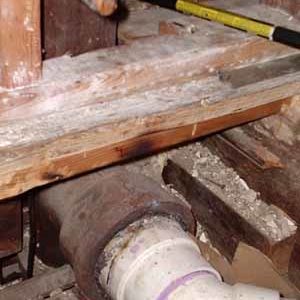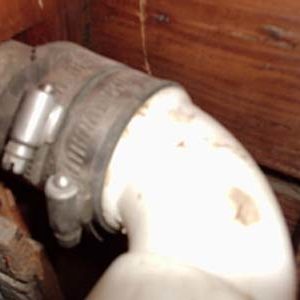The plumber has done rough-in for bathroom remodel. He’s run PVC DWV into existing cast-iron waste stack via existing hub. But it looks like he’s just cemented the PVC directly into the stack. My reading is that a neoprene gasket should intervene between the hub and the PVC. I’ll have to call him back anyway, had to tear out some plumbing to redo some weakened joists and stud walls. Is this an issue I should bring up?
Now that I’m spooked….elsewhere need to connect PVC to vent pipe. My plumber did not do anything here, the pre-existing work is only visible since I removed the hacked-up stud obscuring it. In this case, because of a tight 5-1/4″ space between studs that has to accomodate a coupling and a 90* PVC elbow, it looks like the earlier plumbers hacked away some of the coupling to make it fit. Did they actually remove the stainless steel band in a no-hub coupling? Is there any way to do this right? Looks like Fernco couplings will not fit in this tight space, in any case it may not be a wise choice because of low resistance to shear force….






















Replies
The first pic could be ok. It could be a no hub slip in connection. The pvc going into the ci has a rubber seal on it, that friction fits in the ci pipe. Only way to tell is pull it out a little, or maybe you can see around the joint edge enough to detect the rubber.
Second is hard to tell what is missing. Part of the old ci hub, maybe?
Dave
On the 2nd picture if you are talking about a metal "sleave" that goes other the rubber coupling and then held by the worm clamps there are too styles of couplings. Ones with that sleave and ones without.
Don't know what the differences are but the reducing couplers clearly don't have them.
Here is a drawing for the PVC to PVC/CI for and it does not show a sleave.
http://www.fernco.com/LineArt/1056_150.jpg
By Fernco coupling I'm referring to one without the SS band, I'll refer to one with the band as a (generic) no-hub coupling. Sorry for the bad pic, my little digital can't focus close-up apparently. Anyway I think there is CI pipe, that used to go through several studs. They cut it short (to extend the bathroom), then added this coupling, then added the PVC elbow to send DWV through interior wall. To the left of the clamps you may be able to see the jagged edge of the rubber (with broken lettering), they clearly cut this down from a longer coupling. Looks like a 3-1/2" Fernco coupling is the smallest coupling I can get, I think that'll require cutting down the CI pipe some more....
Can't tell by the photo but you can do a lead joint with a sch 40 pipe. I see some burn marks on pipe and wood. could have been where the plumber heated the lead up in the ladle. scrape the joint to see if it lead. The 2nd looks like some kind of Fernco connecter. I live hear in Davison Mi, world headquarters for Fernco, good product & good company. Just my opinion.
I think it is easier to do it more like the second picture, though without butchering the coupler if possible. Cut the CI after the hub, grind off any raised lettering, and 'Fernco' it (there really are other brands). The couplers with a stainless sleeve and 4 clamps are tougher (to please the overkill types), if you can find them.
Thanks all for the helpful feedback. The original plumbing at the waste stack had a piece of CI connected to the hub and then a coupling connecting that to PVC. My plumber was pretty disgusted with that approach, and took out the CI and fed the PVC straight into the hub. So he probably did do okay, but I appreciate the helpful feedback before I discuss it with him. I didn't know about the lead option for the hub connection. I'll see if I (he) can get a Fernco (or Indiana?) coupling into the vent pipe without butchering it....
Update for anyone that's interested: Fernco has couplings that include elbows for exactly this situation.
http://www.fernco.com/QL.html
I can't say it's wrong, but I've never seen a joint made as pic #1. It looks like he could have snapped off the hub and used a no-hub. It's a horizontal joint and will leak at the bottom unless it's watertight. Did he plug the drain and fill everything with water to test... or are we skipping that step?
Can't tell what's going on in #2.